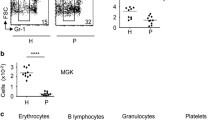Abstract
Human myeloma cells are heterogenous morphologically and phenotypically. Myeloma cells can be classified into at least 5 subpopulations; MPC-1-CD45+CD49e-, MPC-1-CD45-CD49e- immature myeloma cells, MPC-1+CD45-CD49e-, MPC-1+CD45+CD49e- intermediate myeloma cells and MPC-1+CD45+CD49e+ mature myeloma cells. Interleukin-6(IL-6) is a major growth factor for human myeloma cells, but only MPC-1-CD45+CD49e- immature myeloma cells can response directly to IL-6 to proliferate. In the U-266 cell lines, IL-6 can lead to the induction of CD45 expression and CD45+ U-266 cells can proliferate in response to IL-6. In primary myeloma cells, MPC-1-CD45-CD49e-immature myeloma cells sorted from bone marrow samples can be changed to CD45+ cells by addition of IL-6 in vitro. In both CD45- and CD45+ U-266 cells, STAT3 and MAPK(ERK1/2) can be activated in response to IL-6 equally between them, but src family kinases such as Lyn, Fyn can be activated only in CD45+ U-266 cells. Thus, the activation of the src family kinases associated with CD45 expression is a prerequisite for the proliferation of myeloma cells. In the bone marrow of myeloma patients, most myeloma cells do not express CD45, and CD45+ immature myeloma cells are only 1∼2%. In order to clarify the difference of cellular context between CD45- and CD45+ myeloma cells, PCR-based cDNA subtraction was performed from CD45+ U-266 cells to CD45-U-266 cells. The series of this subtraction selected several genes. Furthermore, sensitivity to stress stimuli between CD45+ and CD45- U-266 cells was also compared. CD45-U-266 cells were markedly more resistant to stress conditions such as serum-free condition. Therefore, we can speculate that in the bone marrow of human myelomas IL-6 can induce proliferation of CD45+ immature cells, but the amount of IL-6 is too low to support CD45+ myeloma cells and loss of CD45 results in no direct response to IL-6 to proliferate but confers resistance to stress condition leading to the longer survival at the limited amount of IL-6.
Similar content being viewed by others
References
Kawano M, et al. Autocrine generation and requirement of BSF-2/IL-6 for human multiple myelomas.Nature. 1988;332:83.
Harada H, et al. Phenotypic difference of normal plasma cells from mature myeloma cells.Blood. 1993;81:2658.
Kawano MM, et al. Identification of immature and mature myeloma cells in the bone marrow of human myelomasBlood. 1993;82:564.
Huang N, et al. Heterogeneous expression of a novel MPC-1 antigen on myeloma cellsBlood. 1993;82:3721.
Kawano MM, et al. Differentiation of early plasma cells on bone marrow stromal cells requires interleukin-6 for escaping from apoptosis.Blood. 1995;85:487.
Mahmoud MS, et al. Altered expression of Pax-5 gene in human myeloma cells.Blood. 1996;87:4311.
Mahmoud MS, et al. Induction of CD45 expression and proliferation in U-266 myeloma cell line by interleukin-6.Blood. 1998;92:3887.
Mahmoud MS, et al. Enforced CD19 expression leads to growth inhibition and reduced tumorigenicity.Blood. 1999;94:3551.
Ishikawa H, et al. Requirements of src family kinase activity associated with CD45 for myeloma cell proliferation by interleukin-6.Blood. 2002;99:2172.
Author information
Authors and Affiliations
About this article
Cite this article
Kawano, M.M., Ishikawa, H., Tsuyama, N. et al. Growth mechanism of human myeloma cells by interleukin-6. Int J Hematol 76 (Suppl 1), 329–333 (2002). https://doi.org/10.1007/BF03165278
Issue Date:
DOI: https://doi.org/10.1007/BF03165278




